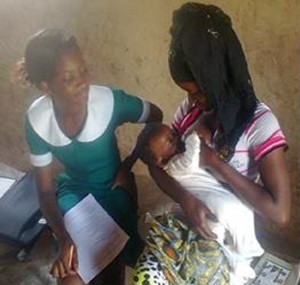Speeches Shim

USAID Nutrition Investments, FY16: $7,000,000
Ghana Quick Facts: Breastfeeding
<40% of children are exclusively breastfed at 4-5 months1
over 1,570 health workers and 2,030 community volunteers in Ghana trained through USAID support.
1 in 3 children under 5 in Northern Ghana are stunted.2
In Ghana, 98% of women report having ever breastfed their children, but proper infant and young child feeding practices, including exclusive breastfeeding and appropriate complementary feeding, are not widely followed.3 In the past decade, Ghana’s exclusive breastfeeding rates have declined from 63 percent in 2008 to just 52 percent in 2014.4 USAID is working in Ghana to improve infant and young child feeding, including breastfeeding practices, as one of many efforts to reduce the country’s high rates of children that are too short for their age, or stunted. The causes of stunting are multifaceted, but the consequences can be detrimental to a child’s cognitive and physical development and economic gains.5
When Madam Kusumi Gipi, a new mother from Northern Ghana, started breastfeeding her infant, she found that the baby was not suckling well during nursing. Mme Gipi worried that she was not producing enough breastmilk to feed her hungry child. During a counseling session with two health workers in her community, she learned that the issues she was having with breastfeeding were not necessarily related to a lack of milk.
Within one-on-one sessions, local health workers use counseling cards and techniques to teach proper breastfeeding practices. During Mme Gipi’s session, health workers asked her to demonstrate how she holds her baby while breastfeeding. The health workers quickly noticed that the baby’s poor position and attachment was leading to the poor suckling and counseled Mme Gipi on appropriate breastfeeding positioning and demonstrated how proper attachment improves the infant’s ability to nurse effectively.
“I thought I did not have enough breastmilk,” she explains, “but now I know I just lacked knowledge on appropriate breastfeeding practices.”
The 1,000 day period from pregnancy through a child’s second birthday is a critical window for proper growth and development. Inadequate nutrition during this period can have lasting impact both during childhood and later in life, such as contributing to childhood stunting.6 Breast milk is the optimal nutrient-rich food for healthy growth and development during the critical 1,000 day period. USAID works with country governments to encourage immediate and exclusive breastfeeding for the first six months of life, followed by complementary feeding with nutritious foods until age 2 and beyond.
The community health workers that counseled Mme Gipi are part of a USAID-funded effort to improve nutrition in Northern Ghana. Health workers receive training that emphasizes early initiation of breastfeeding, exclusive breastfeeding for the first 6 months, and continued breastfeeding with adequate and appropriate complementary feeding from 6 months through at least the first 2 years of life. These feeding behaviors are effective, evidence-based ways to reduce stunting and other forms of undernutrition.6 During these trainings, health workers also discuss the importance of maternal nutrition during pregnancy and while breastfeeding. As a result of this effort, over 1,570 health workers have received training on healthy breastfeeding practices.
Over the past two years, Mme Gipi has met with her local community health worker regularly to ensure that she is practicing the appropriate behaviors to facilitate her child’s optimal physical and mental growth and development. Now 2 years old, Mme Gipi’s son is happy, healthy, and thriving.

From Investments to Impact
Through USAID’s efforts in Ghana, over 1,570 health staff as well as over 2,030 community volunteers and groups from select districts in Ghana have received the training package and been educated on how to use it when counseling pregnant women and new mothers in their communities. 610 Mother-to-Mother Support Groups (MTMSG) were also formed by USAID within communities to provide an opportunity for mothers and caregivers to learn more about proper nutrition practices and share experiences.
Mme Gipi and her son are just one example of the many families that have benefitted from USAID’s efforts in Ghana.Through training local health workers on how to educate pregnant women and new mothers on proper IYCF practices, USAID is strengthening the country’s health workforce and improving the health status of children and mothers. Proper nutrition early in life is necessary to develop a healthy workforce and prosperous nation. The efforts of USAID and our partners to improve IYCF practices during the critical 1,000 day window are contributing to a more prosperous, robust global economy, thereby advancing American security and prosperity.
« Back to the Acting on the Call home page
Ghana 2014 Demographic and Health Survey. The DHS Program, September 2015.
2 Ghana 2014 Demographic and Health Survey. The DHS Program, September 2015.
3 Global Strategy on Infant and Young Child Feeding. The World Health Organization (WHO), April 2002.
4 Exclusive breastfeeding (% of children under 6 months). The World Bank, 2017.
5 WHA Global Nutrition Targets 2025: Stunting Policy Brief. WHO, 2014.
6 Maternal and Child Nutrition. The Lancet, June 2013.
Download the PDF version of this story. [PDF, 3.3MB]

Comment
Make a general inquiry or suggest an improvement.